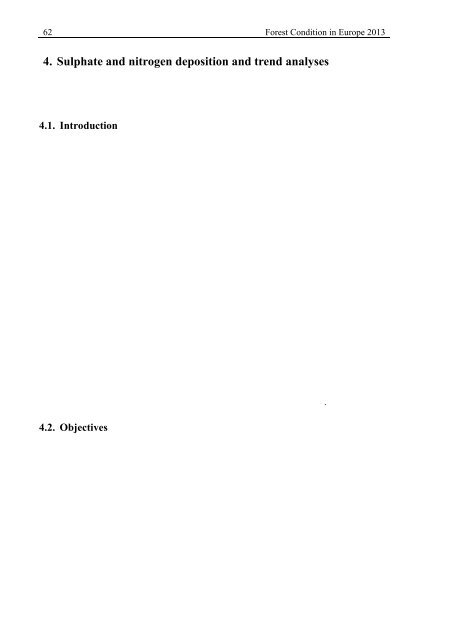Forest Condition in Europe - ICP Forests
Forest Condition in Europe - ICP Forests
Forest Condition in Europe - ICP Forests
You also want an ePaper? Increase the reach of your titles
YUMPU automatically turns print PDFs into web optimized ePapers that Google loves.
62 <strong>Forest</strong> <strong>Condition</strong> <strong>in</strong> <strong>Europe</strong> 2013<br />
4. Sulphate and nitrogen deposition and trend analyses<br />
Peter<br />
4.1. Introduction<br />
The atmospheric deposition of sulphur (S) and nitrogen (N) compounds affects forest ecosystems<br />
through several processes. Deposition of acidify<strong>in</strong>g compounds, <strong>in</strong>organic nitrogen as a<br />
nutrient and base cations to forests <strong>in</strong> <strong>Europe</strong> is a major driver for many processes <strong>in</strong> forests.<br />
The development of deposition is of high <strong>in</strong>terest and therefore, trend analyses of <strong>ICP</strong> forests<br />
deposition data are regularly produced and published (e.g. Lorenz & Granke, 2009). However,<br />
until recently, these trend analyses were usually carried out with data cover<strong>in</strong>g the last six<br />
years only. Trend analyses with longer time series us<strong>in</strong>g l<strong>in</strong>ear regression techniques have<br />
first been <strong>in</strong>cluded <strong>in</strong> the Technical Report 2010 (Granke & Mues, 2010). Trend analyses of<br />
part of the <strong>ICP</strong> <strong>Forest</strong>s deposition data have also been carried out at the national level us<strong>in</strong>g<br />
Mann Kendall tests or autoregressive time series modell<strong>in</strong>g (e.g. Meesenburg et al., 1995;<br />
Kvaalen et al., 2002; Moffat et al., 2002; Lange et al., 2006; Rogora et al., 2006; Wu et al.,<br />
2010b; Graf Pannatier et al., 2011).<br />
The various available techniques have their advantages and disadvantages, and the detection<br />
and magnitude of trends may to some extent depend on the test used. For example, the l<strong>in</strong>ear<br />
regression test cannot dist<strong>in</strong>guish between trends caused by changes <strong>in</strong> precipitation volume<br />
and trends caused by changes <strong>in</strong> the ‘pollution climate’. In comparison, non-parametric tests<br />
such as Seasonal Mann Kendall tests are more robust aga<strong>in</strong>st sporadic events, such as high<br />
calcium (Ca) peaks caused by Saharan dust events. Secondly, the m<strong>in</strong>imal detectable trend<br />
may depend on the uncerta<strong>in</strong>ties <strong>in</strong>cluded <strong>in</strong> the deposition measurements (<strong>ICP</strong>-<strong>Forest</strong>s Manual,<br />
<strong>ICP</strong>-<strong>Forest</strong>s, 2010).<br />
When multiple tests are carried out on a large data set, the possible effect of the size of the<br />
data set needs to be considered. For example, if hundreds of tests are carried out on the basis<br />
of test hav<strong>in</strong>g a probability threshold of 0.01, the probability of some false positive becomes<br />
relevant. On the other hand, even non-significant trends may <strong>in</strong>dicate a significant change,<br />
when the trends have the same direction for most of a large number of trends.<br />
4.2. Objectives<br />
The ma<strong>in</strong> goal of this study is to detect trends <strong>in</strong> deposition at <strong>ICP</strong> <strong>Forest</strong>s Level II sites (with<br />
<strong>ICP</strong> <strong>Forest</strong>s and pre-<strong>ICP</strong> <strong>Forest</strong>s data) and to <strong>in</strong>vestigate possible causes. The specific objectives<br />
are to:<br />
<br />
<br />
<br />
<br />
determ<strong>in</strong>e the bulk and throughfall deposition of sulphate and <strong>in</strong>organic nitrogen (nitrate<br />
and ammonium) and its trends<br />
<strong>in</strong>vestigate the <strong>in</strong>fluence of the trend analyses technique on the detection of statistically<br />
significant trends by compar<strong>in</strong>g the l<strong>in</strong>ear regression test with the Seasonal Mann-<br />
Kendall approach.<br />
<strong>in</strong>vestigate the m<strong>in</strong>imal detectable trend <strong>in</strong> case of deposition measurements made accord<strong>in</strong>g<br />
to the <strong>ICP</strong> <strong>Forest</strong>s Manual.<br />
<strong>in</strong>vestigate and discuss possible reasons for trends on a <strong>Europe</strong>an and a regional level.
















